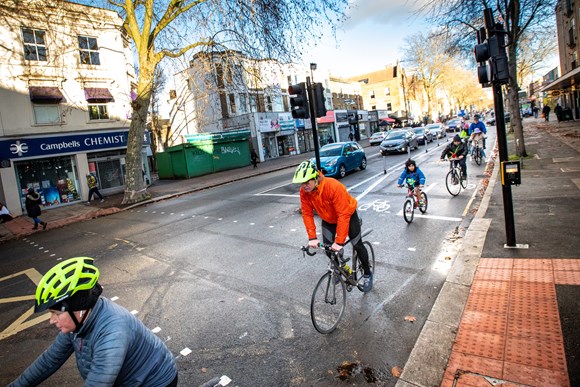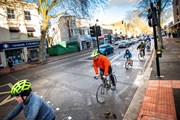
Friday 9 Jul 2021
TfL Press Release - New data highlights success of trial Cycleway in Chiswick including improved road safety and air quality

PN-072
- New data shows cycling has increased by 72 per cent and there have been fewer collisions
- Air quality along the road has improved during the trial, resulting from an increase in cycling and a reduction in motor traffic
- Creating more space for safe walking and cycling is providing a healthier and more sustainable alternative to cars as part of London’s recovery from coronavirus
Transport for London (TfL) and Hounslow Council have published new data that suggests a trial cycle lane in Chiswick has led to a significant increase in the number of people cycling in the area, while also leading to a reduction in the number of people being hurt while cycling.
In December 2020, Hounslow Council introduced trial changes in Chiswick, designed and delivered by TfL, to enable people to make journeys in a safe and sustainable way, including to the many businesses along the road. These changes included a temporary protected cycle lane along Chiswick High Road. The trial cycling route is an amended version of earlier designs for the Cycleway 9 route that had been supported in consultation before the pandemic and were delivered as part of Hounslow Council and TfL’s emergency response to coronavirus.
The new data from TfL and Hounslow Council clearly demonstrates that cycling continues to increase on the already-busy corridor and that there has been a significant fall in cyclist collisions since its installation. The data shows that cycling along the trial route has increased by 72 per cent on weekdays between Februaryand April 2021. Up to 2,700 people a day are cycling along the route, including children and families. Cycling is now a major form of transport for people in the area and around 20 per cent of the ‘vehicles’ using the road during the day are bikes.
Provisional data from the Metropolitan Police also suggests that it is now safer to cycle along Chiswick High Road than before the cycle lanes were introduced. In the 12 months before TfL introduced new temporary cycle lanes to Chiswick High Road, there were eight collisions involving a cyclist, while in the six months since TfL introduced the temporary scheme, there have been two such collisions. Data from an air quality monitoring station in Chiswick High Road opposite Windmill Road also shows an overall improvement in air quality, with levels of nitrogen dioxide, nitricoxide and particulate matter that are consistently lower than before the cycle lane was installed.
Ensuring that people have space to walk and cycle safely will continue to play a central role in London’s recovery from coronavirus. Construction work along the rest of the C9 corridor will continue, with Hammersmith & Fulham Council set to start construction work on a section of their Safer Cycling Pathway between Goldhawk Road and Hammersmith gyratory in the coming weeks.
TfL commissioned independent representative research to get a balanced view from residents in the area. This research shows that there is support from residents for the protected cycle lanes on Chiswick High Road, with 47 per cent in support of the scheme, compared to 43 per cent against. TfL and Hounslow Council have listened to feedback from local residents on the trial and looked carefully at the traffic data to see if changes can be made to improve the scheme. Based on this evidence, Hounslow Council is due to make a decision in the coming weeks about tweaks to the scheme on Chiswick High Road which are intended to help improve bus journey times and reduce congestion in the area, including new eastbound and westbound bus lanes.
Will Norman, London’s Walking and Cycling Commissioner, said: “This data shows the huge positive impact cycle lanes can have not only in enabling more people to cycle, but also in reducing road danger and improving air quality. Chiswick High Road has been transformed by the trial lane, with cycling on weekdays up by almost three quarters and bikes now making up a fifth of ‘vehicles’ using the road during the day. We will continue to work with Hounslow Council and boroughs across London to do all we can to ensure a greener and cleaner recovery from the pandemic.”
Alexandra Batey, TfL’s Director of Investment Delivery Planning, said: “Ensuring that people in London feel safe when cycling is vital and we know that providing space for people to do so can make a real difference in boosting the numbers of people getting around by bike. This important new evidence shows that reducing car-dominance on roads such as Chiswick High Road can enable thousands of safer cycle journeys each week, including by children, families and others who have previously been put off by busy and intimidating roads. We’ll continue to work closely with local councils to ensure that London’s roads play a role in a green, healthy and sustainable recover from coronavirus.”
Cllr Hanif Khan, Cabinet Member for Transport and One Hounslow at Hounslow Council, said: “This new data is evidence of how effective the trial cyclelane in Chiswick has been especially in reducing collisions. It is great that families can cycle around the borough together and feel safer than ever before.
“One of our priorities as the borough recovers from the pandemic is to focus on stimulating a green recovery and this cycle lane is helping us towards our commitment by improving air quality in the area. We will continue to work with TfL to make sure the trial cycle lanes meet the needs of our residents and commuters.”
Simon Munk, Infrastructure Campaigner at the London Cycling Campaign, said: “Cycle tracks like C9 are popular and safer – the evidence on this, despite some controversy, is clearer every day. If we want to move rapidly towards a zero carbon transport system, to reduce road danger, pollution and inactivity, to make London a place where kids can cycle to school and grandparents can cycle to the shops, we need more schemes like this. It is important tweaks are considered to further enhance the scheme for cyclists and pedestrians and improve bus journey times.
“But most importantly, we hope TfL and councils including Hounslow, Hammersmith & Fulham and Kensington & Chelsea work together to rapidly connect this popular cycle track up to other destinations. Because the climate emergency demands climate safe streets.”
Since May 2020 more than 100km of new or upgraded cycle lanes have been built or are under construction, along with more than 22,500 square metres of extra pavement space reallocated for people walking. The measures mean people are increasingly using bikes to get around their local area and for exercise, with recent TfL data showing cycling has increased by 22 per cent in outer London compared to spring 2019, with a seven per cent rise in inner London.
This continued investment in walking and cycling is also central to achieving the Mayor's Vision Zero goal of eradicating all deaths and serious injuries from London's roads by 2041. The risk of a damaging car-led recovery from the pandemic has made it even more important to make it easier for people to walk and cycle, especially as around 40 per cent of Londoners don't have access to a car, with a high proportion of these from low-income households.
Contact Information
TfL Press Office
Transport for London
0343 222 4141
pressoffice@tfl.gov.uk

